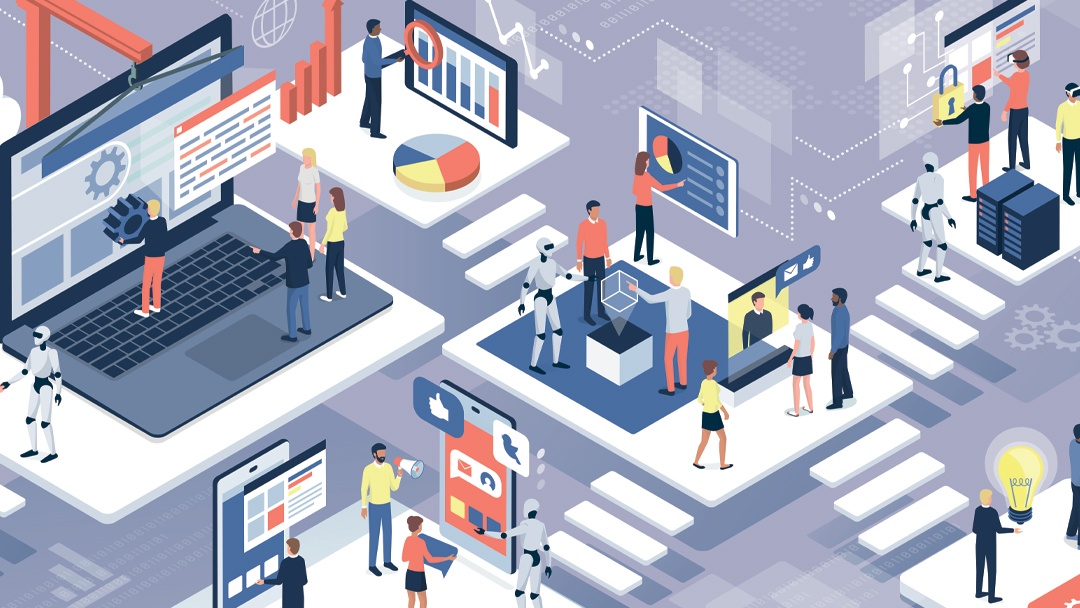In late March, Goldman Sachs analysts predicted that generative AI applications such as ChatGPT risked ‘significant disruption’ to 300 million full-time jobs, with lawyers among the most exposed.
However, the report also found that technology could also unleash a productivity boom, leading to a 7% rise in GDP over the next decade.
According to senior law firm partners and executives canvassed by IHL, AI and other technologies represent an opportunity, rather than posing a risk to highly skilled human roles.
What experts describe is a progression from experimenting with individual tools to a firmwide approach to digital transformation, in line with corporate strategies across sectors. And because technology has become so embedded in their professional (and personal) lives, many lawyers may not even see their roles as digital.
Senior partners and innovation leaders have integrated technology into pitches, budgets and strategy, poaching talent from other sectors, and promoting lawyers with a flair for digital.
They are also trying to avoid technology for technology’s sake, by first taking the time to define what problem they hope new tools will solve. In some cases, it is bottom-up: lawyers requesting solutions to help them complete specific tasks, while in others, it is top-down: change management leaders encouraging staff to reimagine traditional processes.

Tara Waters, Ashurst
Tara Waters, chief digital officer at Ashurst and head of Ashurst Advance Digital explains the trajectory: ‘We started using legal tech ten years ago, for document automation, online collaboration, specific legal applications, as well as individual solutions to do specific tasks. Now, though, it’s about how the different platforms interact and the need to look more holistically at the tech stack.’
The lawyers we spoke to are hopeful that technology will help them work more efficiently, delivering value for their clients. Many embrace the opportunity to do their jobs differently, gain new management skills, set their sights on promotions, or even change careers.
Clients too are expecting, and demanding, that pitches include a strong tech element, and crucially, for both speed and pricing to reflect any automated work. The jury is still out on whether new tools should lead to lower fees, or whether their use enables more time for sophisticated human advice.
Buy, borrow, build
Thanks to the volume of documents and need for precision in any legal case, the profession has always been open to solutions – both human and technological – to work more efficiently.
Laura Fessey, head of legal tech at CMS, summarises the push to practicality described by all the alternative service delivery professionals who spoke to IHL. ‘This isn’t a question of collecting shiny objects, but one that asks “What problem do you want to solve?” The biggest challenge we face when clients and colleagues request tech is establishing what the objective is.’
When tackling a task that might become more efficient, firms first look to large solution providers such as Microsoft and Thomson Reuters, and also increasingly, to in-house development teams.
‘Our approach is buy, borrow or build. Our preferred option is to buy, since it doesn’t make sense to replicate what already exists. We constantly scan the market for new solutions to alleviate pain points for us and our clients. If there isn’t a perfect match, we borrow a best-in-class solution and then tailor it to meet our client needs. And when a solution doesn’t exist, we may choose to create one,’ says Jas Mundae, director of alternative legal services at Linklaters.
The lawyers and executives spoke of the need to move fast, but also stay ‘boring’, meaning that any purchases must be worthwhile, and ideally, be used for multiple functions.
‘For every task, we ask whether there’s a better way of doing things,’ explains Gerrit Beckhaus, partner and co-head of Freshfields Lab. ‘We’ve developed digital collaboration platforms for due diligence, claim management or reorganisations that change how people work, for example by automating tasks or capturing data in a structured form that allows for more data-driven advice and analytics.’
Firms need to look beyond what they are doing internally, thinking ahead to how digital will reach clients.
‘Innovative delivery is how we deliver for our clients efficiently and in a smart way – through machine learning, process and project management and our legally trained people and teams, working directly with our lawyers. To focus too much on tech tools misses the transformative point,’ says Olivia Wyld, global head of the client delivery group at Freshfields.
A key part of this evolution has been the increasing focus on processes and repeatability, both of which can be enhanced by digital tools.
‘For every solution we’ve developed for any mandate, we take a few steps back and “component-ise” parts of a solution that we might be able to reuse in other cases,’ says Beckhaus.
In contract review exercises, for example, his team sets out ‘yes’ or ‘no’ or single-select questions, such as is there a change of control cause, is it triggered in the transaction, does it lead to a termination right? This method, as opposed to describing the clause and its implications in a text, ‘creates structured data, which can be analysed, visualised in interactive dashboards, and extracted into formats like Word, Excel or JSON’.
Case studies
The best candidates for automation are high-data, high-volume areas such as insurance claims, mass litigation, cyber breaches, multi-jurisdictional actions, restructurings and due diligence, practitioners said.
During the pandemic, Ashurst developed an end-to-end flow tool for clients such as Santander to distribute business interruption loans. The collaboration platform allowed its team to input relevant information, generate the secured loan documentation using automated templates, send them to lawyers for review, and then to Santander to finalise. All the documents stayed within the platform, were sent to the borrowers via Docusign, with security documents then filed with Companies House.
‘By building that backbone using existing third-party platforms, we were able to accomplish repeatable business flow tasks within days instead of months,’ says Waters.
Another example is restructuring, said Freshfields’ Beckhaus. A client may have to understand its contractual position under leasing agreements in various scenarios, cluster different groups of lenders, and assess the impact of a default on a certain group of lenders. Lawyers would need to deliver flexible reporting that could be queried by the client: if company X violates its contractual obligations, how could that impact the respective part of the business?
‘We can give the client a simple interactive sheet that allows them to play through various scenarios and assess their contractual position in each scenario,’ he continues.
In Germany, mass litigation involves scores of individual cases, rather than a single class action, explains Jan Wildhirth, head of Fieldfisher X in Berlin. Volkswagen, for example, had to hire more than 20 law firms (Fieldfisher was not involved) to manage the 400,000 claims in its emissions scandal. In contrast, Fieldfisher offers a scalable legal service based on automated solutions, he says.
Linklaters’ Mundae recounts getting a deal over the line thanks to AI-assisted review, which allowed the firm to go through more than 20,000 documents within two or three weeks.

Libby Jackson, Herbert Smith Freehills
‘When we pitch, clients want to know how we will approach a deal, which solutions we will use, what we will report back to them, and when. We can do it faster, and we can do it well. It’s about efficiency – sometimes timing, sometimes cost effectiveness and often a mixture of both,’ says Mundae.
Libby Jackson, managing partner, digital and alternative legal services (ALT) at Herbert Smith Freehills (HSF), recalls a cyber matter that involved a Friday night request to respond to a serious cyber security ransomware incident.
‘Within 48 hours, our team was ready to prepare and load over three million complex data files into our AI tool. The team then ran searches, clustering analytics and other workflows to narrow down the key materials to a set of around 11,000 records to be reviewed by lawyers. By Sunday evening, we assisted the client in assessing the extent of any notifiable data breach and the need for regulatory notifications.’
Professional judgement
The day after Goldman Sachs published its report, Elon Musk alongside more than 1,000 academics and experts called for a six-month ‘pause’ on the development of advanced AI. Their concern was that human-like intelligence could ‘pose profound risks to society and humanity,’ they wrote in an open letter.
Law firms are by definition cautious, and are clear on the need to balance the push towards innovation with ensuring client data is accurate, secure and confidential.
Nigel Lang, chief information officer at Fieldfisher, points out that Microsoft and Google are in an escalating battle of integrating AI into their products, while other off-the-shelf products carry a ‘black box’ risk that he says can be countered with bespoke machine learning algorithms.
Rob Shooter, managing partner at Fieldfisher, is also concerned about the data and black box algorithms that feed into AI.
‘Without access to that black box, how can we be sure as a profession that tasks are free of bias, don’t infringe IP rights and, more generally, are legally correct?
‘And if AI is likely to impact more junior roles, how does the profession ensure that we have the next generation of lawyers coming through who are properly trained? And how is AI output being quality assured and supervised?’
Karim Derrick, product and innovation director at Kennedys IQ, explains how to prioritise professional judgement in automation.
He points to semantic indexing, which enables a machine to read text and extract meaning. This is a technique used to read and grade school exams, while also ‘scaffolding’ teachers’ judgement. Kennedys now applies this method to analysing medical reports as part of insurance claims, which are long, unstructured and cumbersome.
To counter potential bias, he proposes a ‘white box’ technique.
This method ‘takes the benefits of text analysis tools to extract key attributes in the decision process and then uses evidential reasoning to combine evidence and thus optimise decisions, combining legal expertise with machine intelligence.
‘This way, data scientists and lawyers can agree what works and how to apply it, creating a model based on reasoned thought that is then trained with data.’
Digital transformation
Law firms, like business across sectors, experienced an acceleration in digital transformation as a result of the Covid-19 pandemic and lockdowns. The task for senior executives is to determine which technology is really needed, embed new practices, and set out processes that will incorporate and create reliable data.
‘Transformation is graft,’ says HSF’s Jackson. ‘Lots of people are really excited, but my take is practical – client and business-centric. Just because you can doesn’t mean anyone will find it useful.’
‘There has to be the process and the interest: buy, build, operate. What do we have to buy, how can we make it fit well? Most organisations are bad at the steady part (operate), but for digital legal transformation, we want it to become business as usual.’
While Jackson applauds the plethora of new products and legal subsidiaries, she advises a ‘boring’ approach.
‘What we need to do now is simplify, integrate and adopt. What tech we’re using doesn’t matter – it just needs to be presented for maximum end-to-end ease for ourselves and our customers.’
For CMS’s Fessey, the biggest hurdle is often cultural. ‘With lawyers, they’re used to working in a certain way. We need to engage with hearts and minds and explain why this is worthwhile.’
For example, if the management team wants data visualisation, good data is needed, and for there to be good data, everyone in the process needs to be engaged, she explains. ‘The people part is what we’re still working on.’
John Craske, director of innovation at CMS, is calling for both law degrees and professional training to include modules on core digital skills and for black letter law topics to include practical lessons on the use of technology. This would teach professionals how to apply AI functions such as summarisation, image recognition, machine learning and natural language recognition, he says.
HSF’s Jackson, for her part, is keen to convince management that AI and other emerging tech is not a passing fad.
‘Our younger staff are really driven by this, and want to know that senior leaders are driven by it. We need to nurture and develop leaders of the future, and this means showing how tech can ease every moment of their working life.’
Will AI steal jobs, or create them?
While some will understandably be worried about job losses, others will see emerging technology as an opportunity to upskill, get promoted or even chart new careers.
According to Fessey, AI is not at the point where it will replace lawyers. ‘There’s still an element of manual review needed on top of the extracted results coming from any of the AI machine learning platforms – although that has been improving.’
‘The questions are how we will apply AI to more work, how we as an industry experiment with that, what is the risk profile on the extracted results, how can we support that by setting up processes for quality assurance, and how will lawyers bill for it?’ she asks.
What she would advise lawyers who are training – or even already practising – is to consider some of the new roles law firms themselves are eyeing.
These include prompt engineers, whose job it is to get the best out of generative AI, Fessey says. According to LinkedIn, tech companies are also recruiting for this title, and offering salaries of over $300,000.
‘Our kids are being taught that they’ll have jobs no-one has ever heard of,’ says Craske at CMS. ‘The world is moving quickly, and the most recent developments in generative AI will impact what lawyers do and what clients can expect to pay lawyers to do. Everyone is on the edge of their seats. We are right at the beginning, and this is just the trailer for the movie.’


